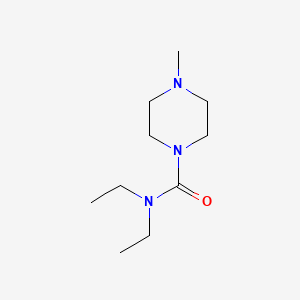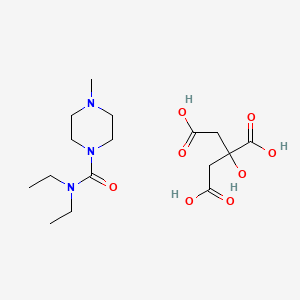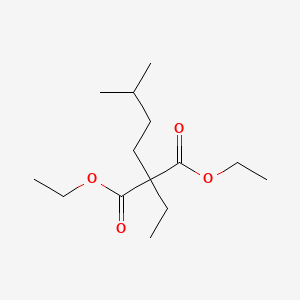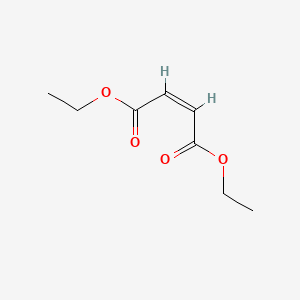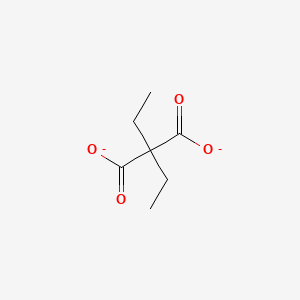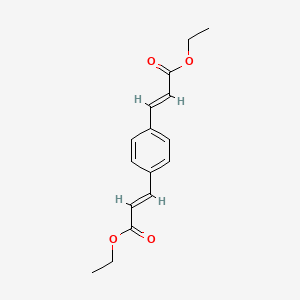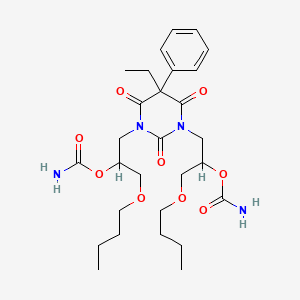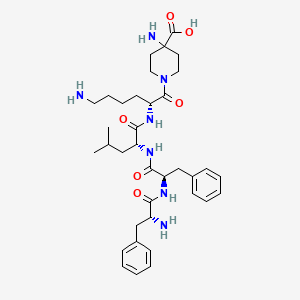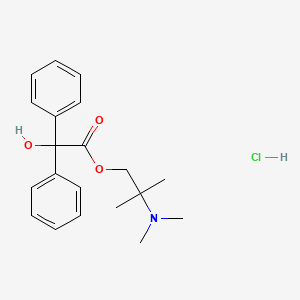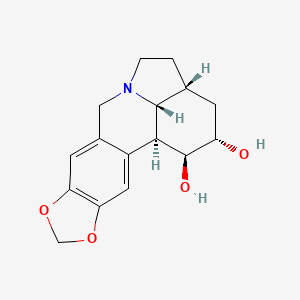
Dihydrolycorine
Overview
Description
Dihydrolycorine is an alkaloid derived from the plant Lycoris radiata. It is a derivative of lycorine, which is known for its various pharmacological effects. This compound has been studied for its potential therapeutic applications, particularly in cardiovascular protection, neuroprotection, and antitumor activities .
Mechanism of Action
Target of Action
Dihydrolycorine, an alkaloid derived from lycorine , primarily targets the Runt-related transcription factor 1 (Runx1) . Runx1 is a gene that plays a crucial role in cardiac function .
Mode of Action
This compound acts as an inhibitor of Runx1 . It interacts with Runx1, leading to its downregulation . This interaction results in a decrease in the expression of fibrotic genes (such as collagen I, TGFβ, and p-smad3), a decrease in the apoptosis gene Bax, and an increase in the apoptosis gene Bcl-2 .
Biochemical Pathways
The primary biochemical pathway affected by this compound involves the downregulation of Runx1 . This downregulation leads to a series of downstream effects, including the prevention of adverse cardiac remodeling . Specifically, it results in the downregulation of fibrotic genes, modulation of apoptosis genes, and improvement of cardiac functions .
Pharmacokinetics
It’s known that this compound has been used clinically due to its better resistance against amebic dysentery and lower toxicity .
Result of Action
The molecular and cellular effects of this compound’s action are primarily seen in its ability to prevent adverse cardiac remodeling . This is achieved through the downregulation of fibrotic genes, modulation of apoptosis genes, and improvement of cardiac functions . Additionally, this compound treatment can rescue cardiomyocyte hypertrophy .
Action Environment
For instance, increased Runx1 expression under pathological conditions results in decreased cardiac contractile function, and this compound can counteract this effect .
Biochemical Analysis
Biochemical Properties
Dihydrolycorine plays a significant role in biochemical reactions by interacting with various enzymes, proteins, and other biomolecules. It has been shown to inhibit methoxamine-induced contraction of isolated rabbit aortic rings and rat anococcygeus muscle . Additionally, this compound interacts with fibrotic genes such as collagen I, TGF β, and p-smad3, as well as apoptosis-related genes like Bax and Bcl-2 . These interactions suggest that this compound can modulate cellular processes related to fibrosis and apoptosis.
Cellular Effects
This compound exerts notable effects on various cell types and cellular processes. In cardiomyocytes, it has been observed to reduce fibrosis and apoptosis, thereby improving cardiac function following myocardial infarction . This compound influences cell signaling pathways by downregulating Runx1, a gene associated with adverse cardiac remodeling . This regulation leads to improved cardiac contractile function and reduced cardiomyocyte hypertrophy.
Molecular Mechanism
At the molecular level, this compound exerts its effects through several mechanisms. It binds to Runx1, inhibiting its expression and activity . This inhibition results in the downregulation of fibrotic and apoptotic genes, thereby preventing adverse cardiac remodeling. Molecular docking and binding modeling studies have identified potential this compound-binding sites in Runx1, further elucidating its mechanism of action .
Temporal Effects in Laboratory Settings
In laboratory settings, the effects of this compound have been studied over various time periods. It has been shown to maintain stability and efficacy in reducing cardiac fibrosis and dysfunction over extended periods . Long-term studies indicate that this compound can sustain its therapeutic effects, with minimal degradation observed in in vitro and in vivo models .
Dosage Effects in Animal Models
The effects of this compound vary with different dosages in animal models. At a dose of 80 mg/kg, this compound significantly reduces mean arterial pressure in normotensive rats . Higher doses have been associated with increased efficacy in reducing infarct size and cerebral edema in a rat model of focal cerebral ischemia-reperfusion injury . Toxic or adverse effects at high doses have not been extensively reported, suggesting a favorable safety profile.
Metabolic Pathways
This compound is involved in several metabolic pathways, interacting with enzymes and cofactors that modulate its activity. It is metabolized in the liver, where it undergoes biotransformation to produce active metabolites . These metabolites contribute to its overall pharmacological effects, influencing metabolic flux and metabolite levels in various tissues.
Transport and Distribution
Within cells and tissues, this compound is transported and distributed through specific transporters and binding proteins. It is known to accumulate in cardiac tissues, where it exerts its therapeutic effects . The distribution of this compound is influenced by factors such as blood flow, tissue binding, and membrane permeability .
Subcellular Localization
This compound localizes to specific subcellular compartments, where it interacts with target biomolecules. It has been observed to accumulate in the cytoplasm and nucleus of cardiomyocytes, where it modulates gene expression and cellular function . The subcellular localization of this compound is directed by targeting signals and post-translational modifications that ensure its proper distribution within the cell .
Preparation Methods
Dihydrolycorine is synthesized through the hydrogenation of lycorine. The process involves the reduction of lycorine using hydrogen gas in the presence of a catalyst, typically palladium on carbon (Pd/C). This reaction is carried out under controlled conditions to ensure the selective reduction of the double bonds in lycorine, resulting in the formation of this compound .
Chemical Reactions Analysis
Dihydrolycorine undergoes various chemical reactions, including:
Oxidation: this compound can be oxidized to form corresponding oxides. Common oxidizing agents include potassium permanganate (KMnO₄) and hydrogen peroxide (H₂O₂).
Reduction: As mentioned, this compound is formed through the reduction of lycorine. Further reduction can lead to the formation of more saturated derivatives.
Substitution: this compound can undergo substitution reactions, particularly at the nitrogen atom. Common reagents for these reactions include alkyl halides and acyl chlorides.
The major products formed from these reactions depend on the specific conditions and reagents used .
Scientific Research Applications
Cardiovascular Protection: Dihydrolycorine has been shown to attenuate cardiac fibrosis and dysfunction by downregulating Runx1 following myocardial infarction.
Antitumor Activity: This compound has demonstrated significant antitumor activity in cancer cells that display resistance to proapoptotic stimuli.
Anti-inflammatory: It has anti-inflammatory effects, making it useful in the treatment of various inflammatory conditions.
Comparison with Similar Compounds
Dihydrolycorine is compared with other similar compounds, such as:
Lycorine: The parent compound from which this compound is derived.
Pseudolycorine: Another derivative of lycorine with similar pharmacological properties.
Lycoramine: A compound with similar structure and pharmacological activities.
Galantamine: Known for its use in the treatment of Alzheimer’s disease, it shares structural similarities with this compound.
This compound stands out due to its lower toxicity and better resistance against certain diseases, such as amebic dysentery .
Properties
IUPAC Name |
(1S,15R,17S,18S,19R)-5,7-dioxa-12-azapentacyclo[10.6.1.02,10.04,8.015,19]nonadeca-2,4(8),9-triene-17,18-diol | |
|---|---|---|
| Source | PubChem | |
| URL | https://pubchem.ncbi.nlm.nih.gov | |
| Description | Data deposited in or computed by PubChem | |
InChI |
InChI=1S/C16H19NO4/c18-11-3-8-1-2-17-6-9-4-12-13(21-7-20-12)5-10(9)14(15(8)17)16(11)19/h4-5,8,11,14-16,18-19H,1-3,6-7H2/t8-,11+,14+,15-,16-/m1/s1 | |
| Source | PubChem | |
| URL | https://pubchem.ncbi.nlm.nih.gov | |
| Description | Data deposited in or computed by PubChem | |
InChI Key |
VJILFEGOWCJNIK-MGRBZGILSA-N | |
| Source | PubChem | |
| URL | https://pubchem.ncbi.nlm.nih.gov | |
| Description | Data deposited in or computed by PubChem | |
Canonical SMILES |
C1CN2CC3=CC4=C(C=C3C5C2C1CC(C5O)O)OCO4 | |
| Source | PubChem | |
| URL | https://pubchem.ncbi.nlm.nih.gov | |
| Description | Data deposited in or computed by PubChem | |
Isomeric SMILES |
C1CN2CC3=CC4=C(C=C3[C@H]5[C@H]2[C@H]1C[C@@H]([C@H]5O)O)OCO4 | |
| Source | PubChem | |
| URL | https://pubchem.ncbi.nlm.nih.gov | |
| Description | Data deposited in or computed by PubChem | |
Molecular Formula |
C16H19NO4 | |
| Source | PubChem | |
| URL | https://pubchem.ncbi.nlm.nih.gov | |
| Description | Data deposited in or computed by PubChem | |
DSSTOX Substance ID |
DTXSID701346488 | |
| Record name | Dihydrolycorine | |
| Source | EPA DSSTox | |
| URL | https://comptox.epa.gov/dashboard/DTXSID701346488 | |
| Description | DSSTox provides a high quality public chemistry resource for supporting improved predictive toxicology. | |
Molecular Weight |
289.33 g/mol | |
| Source | PubChem | |
| URL | https://pubchem.ncbi.nlm.nih.gov | |
| Description | Data deposited in or computed by PubChem | |
CAS No. |
6271-21-2 | |
| Record name | Dihydrolycorine | |
| Source | ChemIDplus | |
| URL | https://pubchem.ncbi.nlm.nih.gov/substance/?source=chemidplus&sourceid=0006271212 | |
| Description | ChemIDplus is a free, web search system that provides access to the structure and nomenclature authority files used for the identification of chemical substances cited in National Library of Medicine (NLM) databases, including the TOXNET system. | |
| Record name | Dihydrolycorine | |
| Source | EPA DSSTox | |
| URL | https://comptox.epa.gov/dashboard/DTXSID701346488 | |
| Description | DSSTox provides a high quality public chemistry resource for supporting improved predictive toxicology. | |
| Record name | 6271-21-2 | |
| Source | European Chemicals Agency (ECHA) | |
| URL | https://echa.europa.eu/information-on-chemicals | |
| Description | The European Chemicals Agency (ECHA) is an agency of the European Union which is the driving force among regulatory authorities in implementing the EU's groundbreaking chemicals legislation for the benefit of human health and the environment as well as for innovation and competitiveness. | |
| Explanation | Use of the information, documents and data from the ECHA website is subject to the terms and conditions of this Legal Notice, and subject to other binding limitations provided for under applicable law, the information, documents and data made available on the ECHA website may be reproduced, distributed and/or used, totally or in part, for non-commercial purposes provided that ECHA is acknowledged as the source: "Source: European Chemicals Agency, http://echa.europa.eu/". Such acknowledgement must be included in each copy of the material. ECHA permits and encourages organisations and individuals to create links to the ECHA website under the following cumulative conditions: Links can only be made to webpages that provide a link to the Legal Notice page. | |
| Record name | DIHYDROLYCORINE | |
| Source | FDA Global Substance Registration System (GSRS) | |
| URL | https://gsrs.ncats.nih.gov/ginas/app/beta/substances/Z7N4S72301 | |
| Description | The FDA Global Substance Registration System (GSRS) enables the efficient and accurate exchange of information on what substances are in regulated products. Instead of relying on names, which vary across regulatory domains, countries, and regions, the GSRS knowledge base makes it possible for substances to be defined by standardized, scientific descriptions. | |
| Explanation | Unless otherwise noted, the contents of the FDA website (www.fda.gov), both text and graphics, are not copyrighted. They are in the public domain and may be republished, reprinted and otherwise used freely by anyone without the need to obtain permission from FDA. Credit to the U.S. Food and Drug Administration as the source is appreciated but not required. | |
Retrosynthesis Analysis
AI-Powered Synthesis Planning: Our tool employs the Template_relevance Pistachio, Template_relevance Bkms_metabolic, Template_relevance Pistachio_ringbreaker, Template_relevance Reaxys, Template_relevance Reaxys_biocatalysis model, leveraging a vast database of chemical reactions to predict feasible synthetic routes.
One-Step Synthesis Focus: Specifically designed for one-step synthesis, it provides concise and direct routes for your target compounds, streamlining the synthesis process.
Accurate Predictions: Utilizing the extensive PISTACHIO, BKMS_METABOLIC, PISTACHIO_RINGBREAKER, REAXYS, REAXYS_BIOCATALYSIS database, our tool offers high-accuracy predictions, reflecting the latest in chemical research and data.
Strategy Settings
| Precursor scoring | Relevance Heuristic |
|---|---|
| Min. plausibility | 0.01 |
| Model | Template_relevance |
| Template Set | Pistachio/Bkms_metabolic/Pistachio_ringbreaker/Reaxys/Reaxys_biocatalysis |
| Top-N result to add to graph | 6 |
Feasible Synthetic Routes
Disclaimer and Information on In-Vitro Research Products
Please be aware that all articles and product information presented on BenchChem are intended solely for informational purposes. The products available for purchase on BenchChem are specifically designed for in-vitro studies, which are conducted outside of living organisms. In-vitro studies, derived from the Latin term "in glass," involve experiments performed in controlled laboratory settings using cells or tissues. It is important to note that these products are not categorized as medicines or drugs, and they have not received approval from the FDA for the prevention, treatment, or cure of any medical condition, ailment, or disease. We must emphasize that any form of bodily introduction of these products into humans or animals is strictly prohibited by law. It is essential to adhere to these guidelines to ensure compliance with legal and ethical standards in research and experimentation.


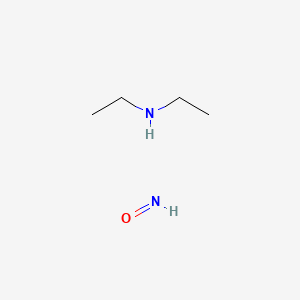

![Diethyl [2,2'-bipyridine]-5,5'-dicarboxylate](/img/structure/B1670527.png)
